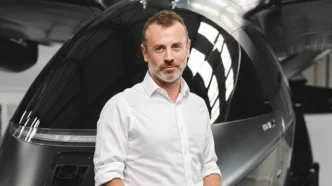Vertical Aerospace is quietly positioning itself as Europe’s next big player in defense tech—just as the continent doubles down on sovereign innovation and military readiness. Known for its electric vertical takeoff and landing (eVTOL) aircraft designed for urban air mobility, the UK-based startup is now stepping into the defense spotlight.
With over 1,500 pre-orders for its VX4 eVTOL from aviation giants like American Airlines, Japan Airlines, GOL, and Bristow, Vertical has already proven it can capture commercial interest. But its ambitions go beyond air taxis. This week, the company announced plans to launch a hybrid-electric version of the VX4, a move that could reshape its role in European security.
CEO Stuart Simpson explained that defense was always part of the roadmap. The hybrid VX4 aims for a range of up to 1,000 miles—ten times the range of its electric predecessor—thanks to its extended capabilities. In a defense context, that kind of leap isn’t just impressive; it’s essential.
What makes VTOL aircraft ideal for military missions is their stealth-like profile. They run quiet, emit minimal heat, and are capable of remote or autonomous operation—capabilities that Vertical intends to build in. The company is already working with Honeywell, a key U.S. military contractor, to develop advanced flight control systems that support these missions.
Why the Timing Works in Vertical’s Favor
The push into defense comes at a moment of opportunity. Russia’s war in Ukraine has spurred a wave of military funding across Europe, and with Donald Trump’s wavering NATO stance, EU countries are urgently investing in home-grown defense tech. In 2023, European defense startups received over $1 billion in venture funding—a fivefold increase since 2018.
Spearheading this investment wave are funds like the €1 billion NATO Innovation Fund and Estonia’s SmartCap defense tech initiative. Even smaller nations like Lithuania are channeling 5–6% of GDP into defense, including through startup investments via sovereign VC Coinvest Capital.
Vertical now finds itself in a market with virtually no local competition. German rivals like Volocopter have filed for bankruptcy, while Lilium has ceased operations. That leaves Vertical as Europe’s sole eVTOL contender with credible scale and momentum.
Other players in the U.S. have made similar moves. Archer Aviation, for instance, launched a dedicated defense division in late 2024 and partnered with Anduril to build a hybrid-electric aircraft. That deal helped it pull in another $430 million in funding. Vertical, meanwhile, insists its hybrid plans weren’t reactionary. The company has been developing the aircraft quietly for the past 18 months.
Still, with defense spending rising and political interest high, the timing couldn’t be better.
Scaling Up, the Vertical Way
But seizing this moment won’t come cheap. So far, Vertical has raised just under $470 million, largely through its 2021 SPAC merger and follow-on PIPE deals. In January 2025, the company secured another $90 million through a direct public offering.
That fundraising pales in comparison to competitors. Joby Aviation has pulled in $2.82 billion, Archer over $3.3 billion, and Beta Technologies more than $1.15 billion. Despite this, Simpson believes Vertical has done more with less. While rivals are spending $400–600 million annually, Vertical has maintained a tight $100 million-a-year budget—even while developing its hybrid aircraft.
He credits that efficiency to focus. Unlike competitors, Vertical isn’t ramping up manufacturing yet. Instead, it’s prioritizing aircraft certification, which it expects to complete by 2028. That contrasts with Joby and Archer, who are pouring hundreds of millions into scaling production now.
“You can burn a lot of money trying to automate too early,” Simpson said. “These aircraft are highly complex. First, you learn how to build them manually. Then you simplify, standardize, and automate.”
The company expects to finish a certified pre-prototype of the VX4 hybrid variant next year and build several more after that. Flight testing of the hybrid powertrain is also scheduled to begin in 2026.
So far, Vertical’s test flights have only been piloted—largely due to the UK’s stringent aviation rules. By contrast, U.S.-based Joby and Beta have already completed piloted test flights, while Archer says it’s preparing to conduct its first.
The Road to Military Adoption
Despite its progress, Vertical hasn’t yet secured a defense contract. But conversations are ongoing, according to Simpson. The startup is actively engaging with government agencies and military customers, and it’s betting that its status as the only serious European eVTOL player gives it a home-field advantage.
“We’ve had a lot of deep, meaningful discussions with government agencies and customers,” he noted. “But we’re the only European player in the space. So it gives us a really unique position.”
As Europe accelerates its investment in strategic defense tech, Vertical Aerospace seems ready to ascend—fuelled by hybrid innovation, stealthy design, and a rare opportunity to lead in a high-stakes market with minimal local competition.













